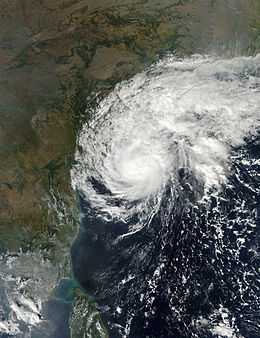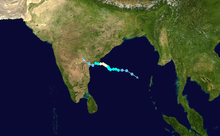Cyclone Helen (2013)
| Severe cyclonic storm (IMD scale) | |
|---|---|
| Category 1 (Saffir–Simpson scale) | |
 Helen near peak intensity on November 21 | |
| Formed | November 19, 2013 |
| Dissipated | November 23, 2013 |
| Highest winds |
3-minute sustained: 100 km/h (65 mph) 1-minute sustained: 130 km/h (80 mph) |
| Lowest pressure | 990 mbar (hPa); 29.23 inHg |
| Fatalities | 11 total |
| Damage | $800 million (2013 USD) |
| Areas affected | |
| Part of the 2013 North Indian Ocean cyclone season | |
Cyclonic Storm Helen is a relatively weak tropical cyclone that formed in the Bay of Bengal Region on November 18, from the remnants of Tropical Storm Podul. It was classified as Deep Depression BOB 06 by the IMD on November 19. As it was moving on a very slow northwest direction on November 20, it became Cyclonic Storm Helen as it brought light to heavy rainfall in eastern India. It then became a Severe Cyclonic Storm on the afternoon hours of November 21.
Meteorological history

Late on November 17, the remnant energy of Tropical Storm Podul contributed to the development of a trough over the Bay of Bengal, located near the Andaman Islands. During the next couple of days, the storm slowly organized and consolidated, prompting the Joint Typhoon Warning Center (JTWC) to issue a Tropical cyclone formation alert (TCFA) during the early hours of November 19.[1] Later on the same day, the India Meteorological Department (IMD) upgraded the storm to a depression, classifying it as BOB 06,[2] followed by the JTWC reporting that the storm had reached Tropical Storm strength.[3] A couple of hours later, the IMD upgraded BOB 06 into a Deep Depression, as the storm continued to intensify.[4]
The storm slowly drifted west-northwestward, while deep convection consolidated around the system's well-defined center of circulation.[5] In the early hours of November 20, the IMD classified BOB 06 as a Cyclonic Storm, thereby officially naming it Helen.[6] Early on November 21, Helen continued to intensify into a Severe Cyclonic Storm, reaching its peak intensity of 100 km/h (62 mph) with a central pressure of 990 mbar (29 inHg).
Shortly before landfall, the storm's convection sheared to the north, causing its low level circulation to fully expose followed by the JTWC issuing its final bulletin, reporting that the storm had weakened due to land interaction.[7] Helen made landfall south of Machilipatnam, Andhra Pradesh and rapidly deteriorated into a deep depression.[8][9]
Preparations and Impact
The Andhra Pradesh government alerted all coastal districts of the state, especially southern coastal districts. The district collectors were directed to evacuate people from low-lying areas near the coast.[10] More than 11,000 people were evacuated from the areas affected by the storm. Ten teams of the National Disaster Response Force were deployed for rescue operations in the affected areas. A total of 10 deaths have been reported in incidents related to the cyclone.[11]
Three boats carrying 20 fishermen were reported missing, out of which two were reported to be safe and on their way back to the coast. Efforts are on to ensure the safety of the third. The Coast Guard's vessel Avantibai and an HAL Chetak helicopter of the Navy have been dispatched for search and rescue of the missing fishermen.[12]
Helen brought extensive damage to Machilipatnam in Krishna district, with uprooted trees and electric lines. The districts of Krishna, East Godavari and Srikakulam, Visakhapatnam and Guntur suffered heavy rainfall. Heavy damage to harvest crops was also reported, with the West Godavari district being worst affected. Paddy, coconut and banana crops have suffered damage.[12] The total loss incurred by Krishna and West and East Godavari districts in the state of Andhra Pradesh due to the cyclone Helen was estimated to be Rs.1,628.73 crore ($262 million).[13]
See also
- Cyclone Mahasen
- Cyclone Rashmi
- Cyclone Bijli
- Cyclone Nilam
- Cyclone Laila
- Cyclone Phailin
References
- ↑ Joint Typhoon Warning Center. "Tropical Cyclone Formation Alert Issued at 19 November 2013, 0200 UTC". Joint Typhoon Warning Center. Retrieved 19 November 2013.
- ↑ India Meteorological Department. "IMD Bulletin 1 for BOB 06 issued on 19 November 2013, 0300 UTC.". India Meteorological Department. Retrieved 19 November 2013.
- ↑ Joint Typhoon Warning Center. "Tropical Cyclone 04B (Four) Warning #01 Issued at 19 November 2013,1500 UTC". Joint Typhoon Warning Center. Retrieved 19 November 2013.
- ↑ "IMD Cyclone Warning BOB06/2013/05 for India". India Meteorological Department. Retrieved 20 November 2013.
- ↑ "Tropical Cyclone 04B Warning 3, issued at 0300 UTC, 20 November 2013". Joint Typhoon Warning Center. Retrieved 20 November 2013.
- ↑ "Cyclone Warning BOB06/2013/08 for India". India Meteorological Department. Retrieved 20 November 2013.
- ↑ Joint Typhoon Warning Center (JTWC). "Tropical Cyclone 04B (Helen) Warning #12 Final Warning Issued at 0900 UTC, 22 November 2013". Joint Typhoon Warning Center (JTWC). Retrieved 22 November 2013.
- ↑ India Meteorological Department. "Severe Cyclonic Storm Helen Warning Bulletin 26 for the Indian coast, issued at 1630 IST (1100 UTC), 22 November 2013". India Meteorological Department. Retrieved 22 November 2013.
- ↑ India Meteorological Department. "Severe Cyclonic Storm Helen Warning Bulletin 27 for the Indian coast, issued at 1900 IST (1330 UTC), 22 November 2013". India Meteorological Department.
- ↑ "Cyclone Helen approaches India's southern coast". Khaleej Times. Retrieved 21 November 2013.
- ↑ http://timesofindia.indiatimes.com/india/Cyclone-Helen-wreaks-havoc-in-Andhra-10-die/articleshow/26224697.cms
- ↑ 12.0 12.1 ANI/PTI (22 November 2013). "Cyclone Helen makes landfall in Machilipatnam region". Deccan Chronicle. Retrieved 22 November 2013.
- ↑ http://www.thehindu.com/news/national/andhra-pradesh/helen-loss-put-at-rs1629-crore-in-three-ap-districts/article5404369.ece
External links
| |||||||||||||
